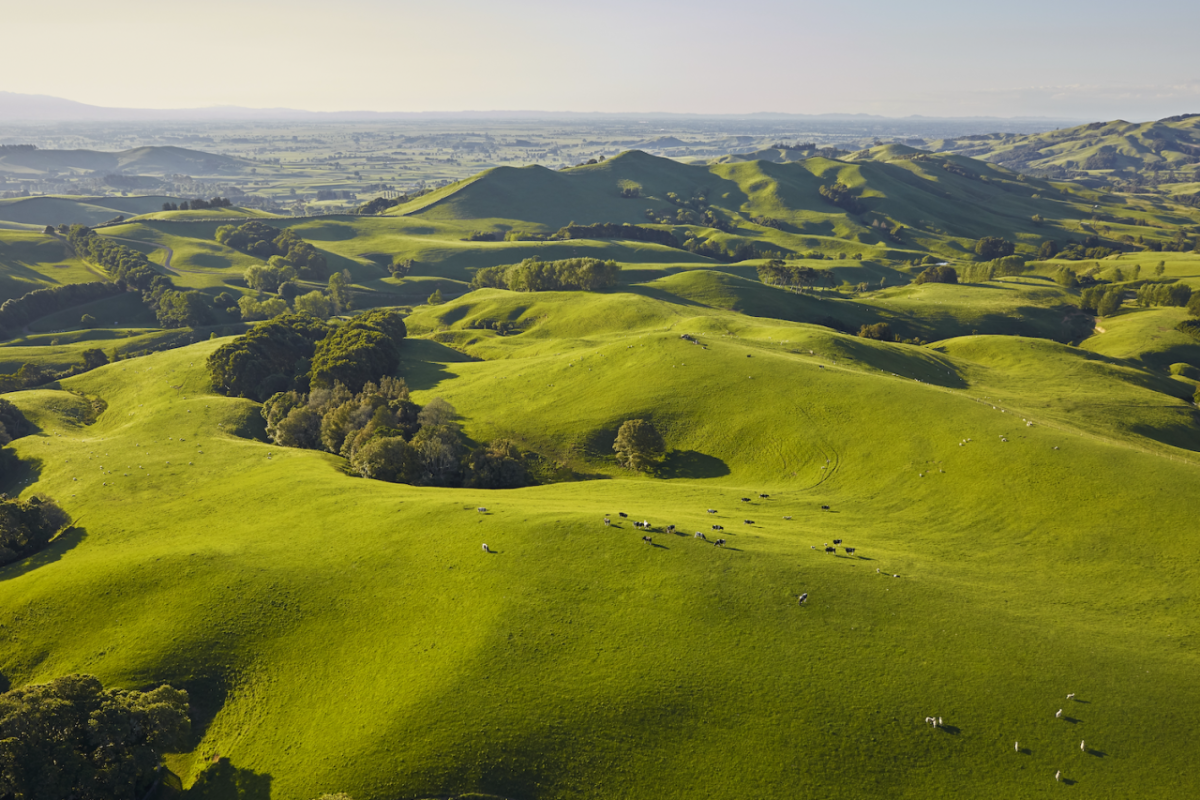New Zealand Leads the Way on Regenerative Agriculture Methods
Words by L. Blaine Fulmer

Originally published by TriplePundit
As nations around the world seek to measure, manage and mitigate their greenhouse gas emissions, many have their eyes focused on the agricultural industry, and New Zealand is no exception. With the New Zealand government’s proposed tax on agricultural emissions, a world first, the local farming industry is now faced with additional considerations to achieve these sustainability goals.
More than 118,000 people work in New Zealand’s agricultural sector. The country’s booming kiwi business produces about 30 percent of the kiwifruits sold worldwide. Other staple crops include wheat, barley, wine grapes and avocados, but the country’s top agricultural exports center on livestock like sheep and beef and dairy cattle.
While livestock farming typically comes with a higher greenhouse gas (GHG) footprint, the country’s moves to embrace regenerative agriculture positions farmers to cut these impacts down to size.
Regenerative agriculture practices reduce the impact of beef and sheep farming in New Zealand
The New Zealand landscape is uniquely suitable for regenerative and grass-fed farming, Beef + Lamb New Zealand, a farmer-owned industry organization representing New Zealand's sheep and beef farmers, told TriplePundit. With a temperate climate and abundant rainfall, New Zealand pastures are perennial and used in perpetuity, with high-quality grass for both cattle and sheep herds.
These unique characteristics also lend themselves to the regenerative agricultural practice of rotational grazing, and New Zealand farmers have harnessed the power of rotational grazing since the 1970s. The quality of New Zealand pastures allow both sheep and cattle to graze in the same pastures at different stages of the grazing process, utilizing the pastures at maximum efficiency with minimal need for agricultural inputs like fertilizer, feed or other chemicals.
In order to better utilize these unique natural advantages, Beef + Lamb New Zealand aims to help its farmers adhere to sustainable agricultural practices that advance local productivity and increase market returns.
“Building sustainable and profitable businesses is one of the biggest issues our farmers face today and in the future,” Beef + Lamb New Zealand CEO Sam McIvor told TriplePundit. “Farmers and the agriculture industry are some of the most impacted by climate change, so we collectively invest to support our nation of family farmers and ensure their viability today and for future generations.”
A life cycle assessment brings the impact of New Zealand’s regenerative agriculture practices into focus
Beef + Lamb New Zealand also aims to better understand the impact of its farmers’ products through the entire value chain, particularly as an industry that exports 90 percent of what they produce.
To do so, the organization recently commissioned an extensive life cycle assessment (LCA) study with AgResearch to capture the broader picture of the sector’s emission impacts from farm to plate. The LCA study includes data from across the value chain and converts every GHG emission into a unit of measurement known as CO2e, carbon dioxide equivalent, that indicates global warming potential.
While this methodology helps give a comprehensive picture of the emissions associated with a given farm, including methane and nitrous oxide, the assessment also looks beyond the farm itself.
“From the LCA perspective, when you think of an animal, you think of a product that is raised and ultimately becomes meat on the table,” said Dr. Stewart Ledgard, principal scientist with AgResearch and one of the researchers who conducted the analysis for Beef + Lamb New Zealand. “But it's not just the animal — that animal has actually got a breeding system component behind it. There are various inputs that go into the farm system, and we are accounting for the whole system.”
The LCA revealed that regenerative agriculture practices helped New Zealand sheep and beef farmers significantly reduce emissions, making the country one of the most carbon efficient in the world. When taking into account the entire value chain, the carbon footprint of New Zealand lamb is around 14.7 pounds of CO2e per pound of meat, while New Zealand beef comes to nearly 22 pounds of CO2e per pound. That’s compared to a global average of around 40 pounds of CO2e per pound of lamb and over 100 pounds of CO2e per pound of beef, according to a 2021 research review.
Communicating with consumers to cut footprints at the grocery store
While much of its work revolves around farmers, their livestock and the wider industry at a global scale, Beef + Lamb New Zealand also looks to leverage advocacy and research to help consumers make more informed choices.
Through New Zealand’s Farm Assurance Program, farmers are audited every three years by an independent third party to ensure that both domestic and international food safety standards are met. The Farm Assurance certification also gives evidence-based backing to brand efforts around integrity, traceability, and health and welfare of both farmers and their animals — providing consumers with clear guidance as they shop.
The bottom line: New Zealand is positioned to guide the world’s way on regenerative agriculture
All nations face significant challenges ahead as they look to mitigate their greenhouse gas emissions, and New Zealand’s government and agricultural industries are facing these issues head on — offering a valuable example for other countries.
By advocating for the unique advantages of the New Zealand landscape and utilizing a scientific, evidence-based approach to their agricultural industry, this lush island nation is well on the way to ensuring its natural beauty and resources are preserved, while continuing to provide the world with a bounty of high quality agricultural exports.
This article series is sponsored by Beef + Lamb New Zealand and produced by the TriplePundit editorial team.
Image courtesy of Beef + Lamb New Zealand

